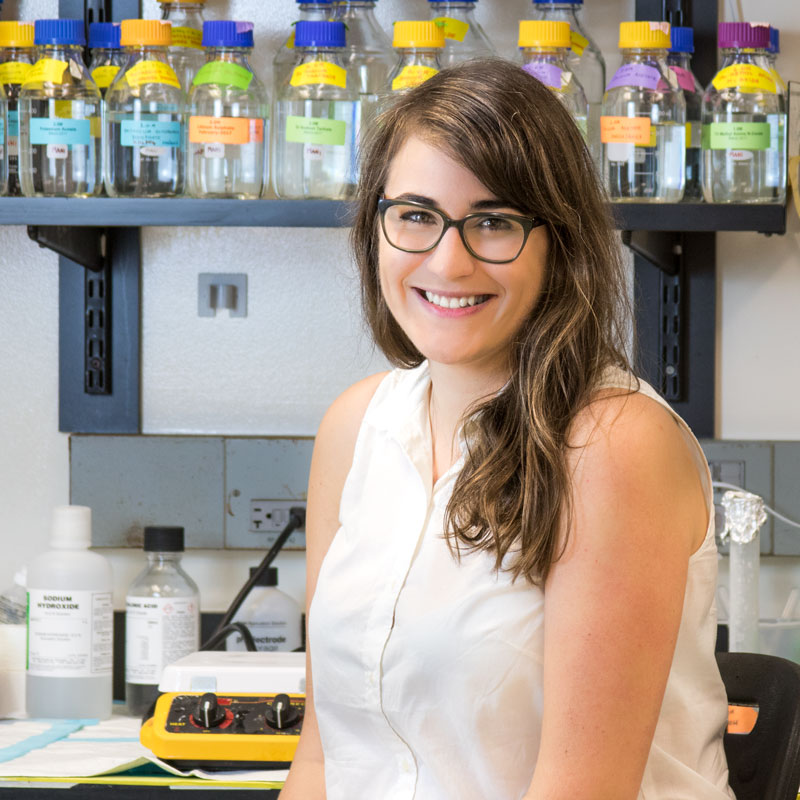Meet HDSA’s 2018 Berman-Topper fellow Dr. Rachel Harding, who is working with Drs. Cheryl Arrowsmith and Ray Truant to understand how Huntingtin interacts with DNA repair proteins. She shares how she became involved in HD research, what she does outside the lab, and provides a link to follow along with her work in real time.
What has the grant support from HDSA meant to you?
I am incredibly honored and grateful to have been awarded this fellowship. Having 3 years of funding will allow me to explore some of the more complex questions we have about the huntingtin protein and its role in healthy populations as well as HD patients. I hope that this fellowship will lay the path to my future career as an independent HD researcher.
Can you tell us a little about your academic background and how you got involved in HD research?
I completed both my undergraduate degree and PhD at the University of Oxford in the U.K.. My training was in structural biology and protein biochemistry with a focus on understanding molecular mechanisms in human disease, in particular meningococcal infection. After completion of my PhD, I moved to Canada where I started my postdoctoral training at the Structural Genomics Consortium at the University of Toronto. Initially I worked on a drug discovery project targeting histone deacetylase 6, a therapeutic target for multiple myeloma. I then began working on HD, generating open resources for the HD community to further biochemical efforts in understanding the huntingtin protein. I became instantly hooked on the paradigm of a seemingly simple mutation giving rise such severe symptoms in patients.
What do you like most about the field of HD research?
I have always been interested in the intricacies of biology; how do the molecules in the cells of our bodies work to give rise to the complex structures and functions we observe in health and disease? From this perspective, the huntingtin protein is very intriguing, as a seemingly small alteration in a huge molecule leads to devastating outcomes for patients. Unpicking this complex biochemistry to further understand the disease and perhaps shine a light on novel therapeutic strategies is something which fascinates me academically.
What is your biggest challenge or struggle in the lab?
When doing more complex experiments, I can be frustrated by how long it can take to get the final data or results – I am so excited I want to know the outcome immediately! However, being patient and having validated results, confirmed with parallel approaches, is much more important than jumping to unfounded conclusions.
Have you had a mentor that stands out to you? Tell us how they’ve helped you.
Throughout my scientific training, I have been incredibly lucky to have a series of fantastic mentors so it would be difficult to highlight just one. Dr. Mary Board was my undergraduate tutor and always encouraged me to strive for academic excellence whilst fostering critical thinking of different scientific problems. Prof. Susan Lea supervised my PhD and really ignited my interest in structural biology and understanding complex molecular mechanisms of biochemistry through the solution of protein structures. Prof. Cheryl Arrowsmith is my postdoctoral supervisor and has always given me freedom in the lab to explore what interests me whilst offering excellent guidance to ensure my work is robust and scientifically sound as well as encouraging me to take on more of a leadership role in directing my independent research strategy. I am incredibly thankful to have had such fantastic female scientific role models.
In layman’s terms, please tell us some highlights about your project funded through the HDSA HD Human Biology Project.
HD patients all have a mutation in the huntingtin gene but there is still a lot we don’t know about the huntingtin protein which it encodes. In recent years, evidence for the role of huntingtin protein in DNA repair pathways in our cells has been building, with genetic risk factor analysis of HD patients pointing to genes in this pathway, localization of huntingtin in our cells at sites of DNA damage as well as studies showing that huntingtin might bind onto both DNA and DNA repair proteins directly.
Previous work in the laboratory allows us to make large quantities of pure samples of the huntingtin protein with and without the polyQ expansion, representing huntingtin protein from the general population and HD patients. Using these samples, we plan to probe the interactions of huntingtin with DNA and DNA-repair proteins and to characterize the complexes huntingtin makes with these molecules. Structural biology approaches are methods which allow the precise 3D structure determination of protein molecules which can give insight into how proteins might work in our cells. I plan to visualize individual molecules of the huntingtin protein bound to DNA or DNA repair proteins identified in the interaction investigations, using cutting-edge cryo electron microscopy as well as X-ray crystallography methods. These experiments should allow us to model the huntingtin protein molecule at atomic resolution and give insight into the molecular mechanisms which link huntingtin with the DNA damage repair pathways.
What is the potential impact of your project on HD research?
This HD research project aims to shine a light on the biochemical functions of the full-length huntingtin protein with respect to DNA damage repair, a hallmark of many neurodegenerative diseases. There is currently very limited information available in the published scientific literature about huntingtin protein biochemistry with respect to this putative function. All outputs from this project will be documented in my open notebook LabScribbles and we will also be sharing materials generated in the course of this work to reduce redundancy amongst HD researchers and to hopefully speed up the science so we can get on with answering the big questions around HD pathobiology, not duplicating effort.
When you are not locked away in the lab, what do you do for fun? Do you have a special talent that most people would not know about you?
I am a keen cyclist and cycle everywhere nearly all year round (Toronto winters make certain months of the year more challenging to negotiate on two wheels). My fold up Brompton bicycle often makes its way with me to conferences so you may see me whizzing around at the next HDSA meeting!

 Dr. Rachel Harding
Dr. Rachel Harding 